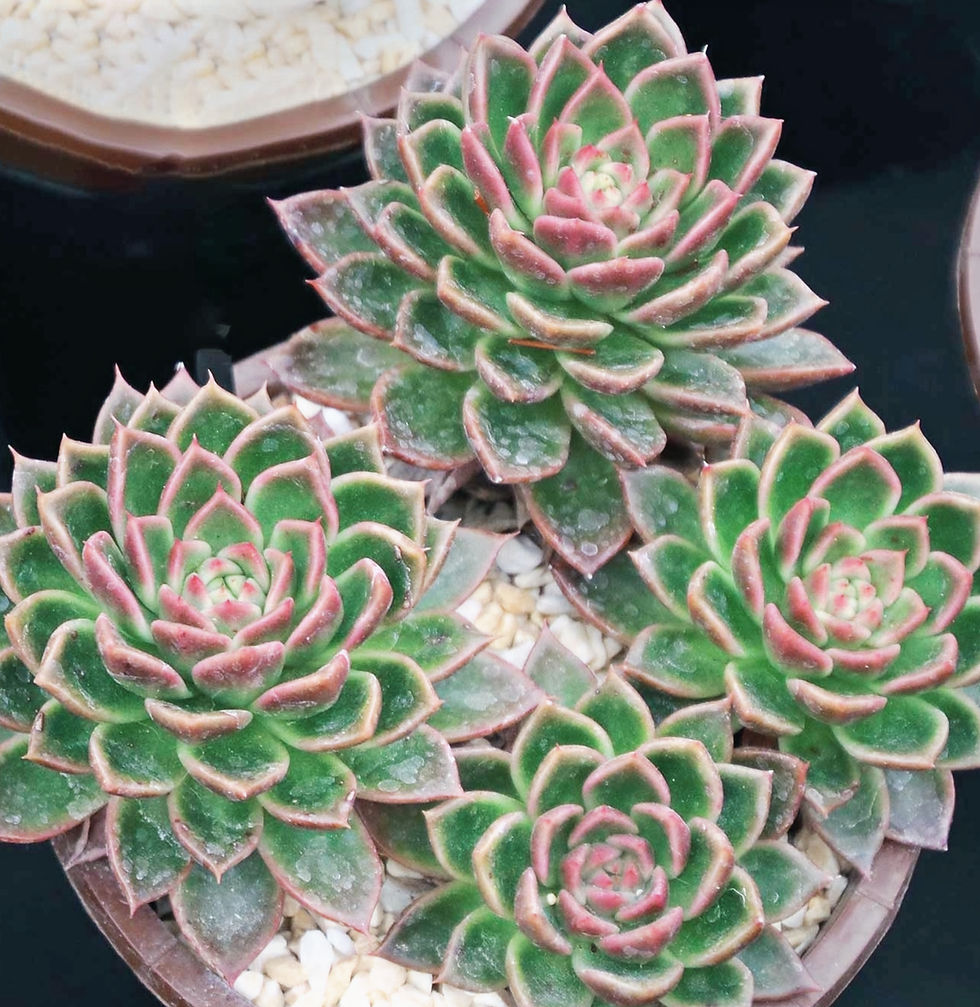Echeveria Genus The Ultimate Guide to Caring for Echeveria Succulents: Tips and Maintenance
- Elevated Succulents

- Sep 22
- 4 min read
If you’re looking to add a touch of beauty to your space, Echeveria succulents are an excellent choice. Their captivating rosette shapes and striking colors make them favorites among plant lovers. Not only are they low-maintenance, but they can also thrive in various conditions, which makes them ideal for both beginners and seasoned gardeners. This guide will cover everything you need to know about caring for Echeveria succulents, from watering and sunlight needs to pest control and propagation techniques.
Understanding Echeveria Succulents
Echeveria is a genus of flowering plants belonging to the Crassulaceae family, with origins mainly in Central America. These succulents are known for their fleshy leaves that can hold water, allowing them to survive in dry environments. There are over 150 species of Echeveria, showcasing various shapes, sizes, and colors. For example, Echeveria ‘Lola’ has soft lavender-pink leaves, while Echeveria ‘Black Prince’ features dark, almost black rosettes. Their versatility makes Echeveria a great addition to indoor and outdoor gardens alike.
These plants are often seen in arrangements and terrariums, standing out with their unique shapes and low upkeep requirements, which appeal to many succulent enthusiasts.
Light Requirements
For optimal growth, Echeveria succulents need bright, indirect sunlight. Aim for at least six hours of light daily. A south or west-facing window usually provides the best light. However, it's crucial to avoid direct sunlight as it can lead to leaf scorch, which may appear as brown patches.
If you notice your Echeveria stretching or leaning toward the light, it means it isn't getting enough illumination. Try relocating it to a brighter spot or using grow lights. In fact, studies show that Echeveria plants can thrive with about 75% brightness compared to full direct sunlight.

Watering Guidelines
Watering is one of the most crucial aspects of Echeveria care. These succulents prefer to dry out completely between waterings. Overwatering is a common mistake that can lead to root rot. Here are some straightforward guidelines:
Check the Soil: Before watering, insert your finger about an inch into the soil. If it feels dry, it’s time to give your plant some water.
Watering Technique: Water thoroughly until it drains from the bottom of the pot. Ensure that excess water does not sit in the saucer, which can lead to root rot.
Seasonal Adjustments: During the growing season in spring and summer, you may need to water your Echeveria more frequently. In the fall and winter, cut back on watering as the plant enters dormancy.
Soil and Potting
Echeveria succulents thrive in well-draining soil to prevent excess moisture. A cactus or succulent potting mix works well, but you can create a custom blend by adding sand or perlite to regular potting soil. For example, a mix of 50% potting soil and 50% perlite can work very effectively.
Choose a pot with drainage holes to allow water to escape. Terracotta pots are excellent for this purpose, as they help draw moisture away from the roots, keeping them healthy.

Fertilizing Echeveria
Echeveria succulents do not need frequent fertilization. However, providing nutrients during the growing season can help them flourish. Use a diluted, balanced fertilizer designed for succulents or cacti every four to six weeks from spring to early fall.
Avoid fertilizing in winter when the plant is dormant. Over-fertilizing during this time can lead to nutrient buildup, which may harm your plant.
Temperature and Humidity
Echeveria succulents prefer temperatures between 60°F to 80°F (15°C to 27°C). They can tolerate slightly cooler conditions but should be shielded from frost, as it can damage their leaves.
These plants thrive in low-humidity environments, making them ideal for dry indoor spaces. If you live in a more humid area, make sure there’s good air circulation around your Echeveria to prevent fungal issues.
Pest Control
While generally resistant to pests, Echeveria succulents can sometimes attract mealybugs, aphids, and spider mites. Regularly inspect your plants for signs of infestation, such as sticky residue or webbing.
If you spot pests, treat them quickly using insecticidal soap or neem oil. For minor problems, a gentle spray of water can help remove many pests.
Propagation Techniques
One of the joy-filled aspects of caring for Echeveria succulents is propagation. You can propagate these plants easily through leaf cuttings or offsets. Here’s how:
Leaf Cuttings: Gently detach a healthy leaf from the parent plant, allowing it to callous over for a few days. Once dried, place it on well-draining soil and mist it lightly. Roots should develop within a few weeks, enabling further growth.
Offsets: Many Echeveria species will produce offsets or "pups" at the base. Carefully remove these pups and plant them in their own pots for new growth.
Common Issues and Solutions
Despite their resilience, Echeveria succulents can face common challenges:
Overwatering: Yellow leaves or mushy stems signal that your plant is receiving too much water. Allow the soil to dry completely and reduce your watering frequency.
Underwatering: Wrinkled or shriveled leaves indicate your Echeveria is thirsty. Adjust your watering schedule to hydrate your plant properly.
Sunburn: Brown patches on the leaves can be a sign of too much direct sunlight. If this occurs, move the plant to a spot with filtered light.
Tips for Thriving Echeveria Succulents
Caring for Echeveria succulents can be rewarding and enjoyable. With the right light, watering schedules, and maintenance practices, these beautiful plants can flourish and enhance your home or garden. Whether you're a novice gardener or an expert, the tips in this guide will help you grow healthy Echeveria that can thrive for years to come. Happy gardening!

_edited_edited_edite.png)




Comments